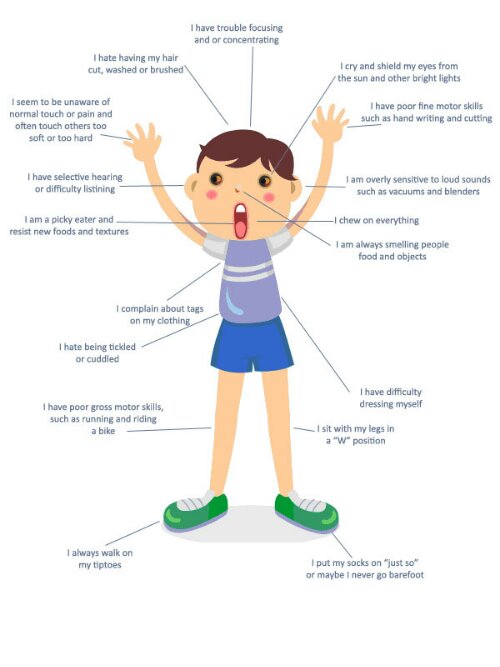Alyssa Z is an Autistic friend of mine who struggles with sensory processing issues. We spoke awhile back about the topic of sensory processing disorder and she wanted to share her personal insight and advice in an effort to help parents that are trying to help their kids with sensory processing issues.
You can find her personal blog here: Yes, That Too.
I would like to thank Alyssa for reaching out and help parents like myself with their spectrum kids by providing invaluable insight and advice. 🙂
Sensory Processing Dysfunction
Clothing:
- Certain fabrics can be problems. Which ones will vary from person to person, but don’t try to make someone wear a fabric that is a sensory issue. Finding different clothes is worth it. Learning how to make them yourself and then doing so is worth it if it comes to that.
- Tight clothing may be a problem. If so, do not force your kid to wear stockings, leggings, or other tight clothing. Comfort is a prerequisite to being able to function, and it’s still more important than looks.
- Footwear can also be interesting. Many people do best with crocs, some with sandals, some barefoot. Try different things if shoes are a problem.
- Some people just can’t wear socks. If this is you or your kid, choose shoes accordingly so that you don’t get blisters.
- Short of legal regulations such as requiring shirt and shoes to be served and the issue of indecent exposure, all dress codes can be modified for disability. It’s no different from the person who has a doctors note saying that they have to wear sneakers instead of dress shoes.
- Puberty doesn’t make SPD go away. Whatever the requirements for clothing may have been, expect it to continue, and expect either the same requirements or stricter ones to apply to any new undergarments.
Hygiene:
- Mint is actually a pretty common issue. It’s a strong sensation, and people either love it or hate it, and a lot of people with SPD fall into the “hate it” camp. Toothpastes that are not mint flavored may be harder to find, but if mint is an issue, this is more than worth the time. Flosses that are not minty may also be a good idea. If this is an issue, be prepared to argue with the dentist about it, because they will have trouble with this one, especially with older Autistic people.
- Try all different kinds of toothbrushes. Electric ones are actually worse than manual ones for me, something about the vibration.
- If brushing hair is an issue, get a haircut. Comfort is more important than looks, and anyone who tells you different is to be laughed out the door.
- Unscented soaps and deodorants are your friend.
Food:
- Bring snacks with you, so you can still eat even if all the food you are provided with is a sensory issue.
- Mint again: If this is an issue, smell chocolates and other offered desert items before biting. People won’t always tell you that these contain mint because it doesn’t register as an important thing to tell people.
- Carbonated beverages can be painful. If they are for you or for your kid, bring something you can drink. You have no idea how many times I have gone to social events only to find that every beverage they offer is carbonated, and I can’t drink them. Even shaking and stirring to try to make them go “flat” isn’t enough.
- Similarly, don’t tell someone that “flat” sodas are OK if carbonation is an issue. They aren’t.
- If water is OK (some people can’t swallow tasteless things,) don’t be afraid to ask for an empty cup and find a sink or water fountain. You don’t even need to disclose a disability for that.
- There may be a lot of healthy foods that you or your child can’t eat. That’s OK, find the ones you can eat. Yogurt, puddings, and scrambled eggs are all problems for me because of the texture, and re-fried beans aren’t great either. But there are other things I can eat. And I concentrate on those instead. Worst case, you need some supplements.
- As far as the focusing on things you or your child can eat goes: If you don’t have a medical reason that you need to avoid gluten, casein, or any other specific group of foods, don’t try. It’s just going to reduce further the space of things you can eat, and then you will be sad. If you have a medical reason, you obviously need to do it, just be aware and allow extra time for finding things you or your kid can eat.
- This might lead to eating foods at “strange” or “inappropriate” times. It might also lead to some “strange” snacks. Just go with it. I can’t remember the last time I ate a “typical” breakfast, and I’m fine. It’s just a result of sensory issues.
- A “try one bite, and if it’s that bad you can spit it out” rule for trying new foods is about the most you can realistically try for with Autistic people, and demanding re-tries of bad foods is not a good idea. If the scent alone is a sensory issue, don’t even push for the bite. It’s not worth it.
Other At Home:
- People talk about “brushing” as an occupational therapy thing. If you or your kid are or may be seeking for that, go ahead and try it, but if it is uncomfortable, stop immediately. That one specifically is often painful.
- When people are in sensory overload, they often stim more. Don’t quiet hands them (never quiet hands anyone!) look for what is causing the overload. While some stimming is fun, stimming that is induced by sensory overload is a coping mechanism to avoid insta-meltdown, and it is often just a delaying tactic.
- Having a sensory room in the house that has a bunch of things with good textures, is at a good level of light (probably adjustable,) is quiet, and has enough space for things like rocking or spinning is a good idea. Exactly what goes in it will depend on specific sensory needs. Even if it is just a corner of a room with a curtain around it, this is hugely useful.
- Also, if there are multiple people in the household with different sensory needs, they might need separate rooms for this. Plan like every person in the household will all need their sensory space at the same time, and then you’ll be OK even if that happens.
- Taking a break to calm down and recover after sensory overload is better than pushing it and a meltdown.
Other School/Work/Going Out:
- Sometimes knowing that a sensation that triggers sensory issues is coming ahead of time can help. If so, having “gets advanced notice of fire drills” or “is seated facing the clock” as accommodations can help.
- Strobe lights can be extremely disorienting, even for those of us who are not officially considered photosensitive. It’s not the same level of dangerous for us as for a person with photosensitive epilepsy unless we actually have photosensitive epilepsy, but it’s still good to avoid. Turn flash off if this is an issue.
- Carry a stim toy, always. By stim toy I mean something you can use to get a sensation for which you are sensory seeking. Maybe carry multiple. Certainly have one that can be used discretely.
- Noise-cancelling headphones are your friend.
- Distracting yourself or your kid with a cell-phone, iPad, whatever kind of electronic game ASAP when entering a potentially overloading environment can be a lifesaver. If this is what’s going on, don’t take the device away.
- Even when you’re out, still don’t stop a person from using their “sensory overload coping” stims. No matter how embarrassing you think they are, a those plus a meltdown is even more embarrassing for you and your kid, plus painful for your kid. Exiting the situation is a better choice.
Many of the tips in this post were adapted from these prior posts of mine:
Sensory Friendly Diets, Or Why I Eat Weird
Sensory Processing Disorder-Autism Parenting (I reviewed their article of the same title and added my own tips.)





Sharing via –
http://www.facebook.com/RockinRidinForAutism